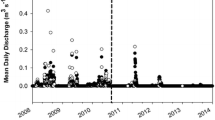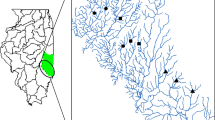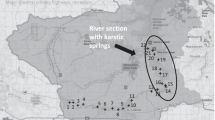Abstract
We assessed the relationship between riparian management and stream quality along five southeastern Minnesota streams in 1995 and 1996. Specifically, we examined the effect of rotationally and continuously grazed pastures and different types of riparian buffer strips on water chemistry, physical habitat, benthic macroinvertebrates, and fish as indicators of stream quality. We collected data at 17 sites under different combinations of grazing and riparian management, using a longitudinal design on three streams and a paired watershed design on two others. Continuous and rotational grazing were compared along one longitudinal study stream and at the paired watershed. Riparian buffer management, fenced trees (wood buffer), fenced grass, and unfenced rotationally grazed areas were the focus along the two remaining longitudinal streams. Principal components analysis (PCA) of water chemistry, physical habitat, and biotic data indicated a local management effect. The ordinations separated continuous grazing from sites with rotational grazing and sites with wood buffers from those with grass buffers or rotationally grazed areas. Fecal coliform and turbidity were consistently higher at continuously grazed than rotationally grazed sites. Percent fines in the streambed were significantly higher at sites with wood buffers than grass and rotationally grazed areas, and canopy cover was similar at sites with wood and grass buffers. Benthic macroinvertebrate metrics were significant but were not consistent across grazing and riparian buffer management types. Fish density and abundance were related to riparian buffer type, rather than grazing practices. Our study has potentially important implications for stream restoration programs in the midwestern United States. Our comparisons suggest further consideration and study of a combination of grass and wood riparian buffer strips as midwestern stream management options, rather than universally installing wood buffers in every instance. RID="" ID="" The Unit is jointly sponsored by the US Geological Survey, Biological Resources Division; the Minnesota Department of Natural Resources; the University of Minnesota; and the Wildlife Management Institute.
Similar content being viewed by others
Author information
Authors and Affiliations
Rights and permissions
About this article
Cite this article
Sovell, L., Vondracek, B., Frost, J. et al. Impacts of Rotational Grazing and Riparian Buffers on Physicochemical and Biological Characteristicsof Southeastern Minnesota, USA, Streams. Environmental Management 26, 629–641 (2000). https://doi.org/10.1007/s002670010121
Published:
Issue Date:
DOI: https://doi.org/10.1007/s002670010121




